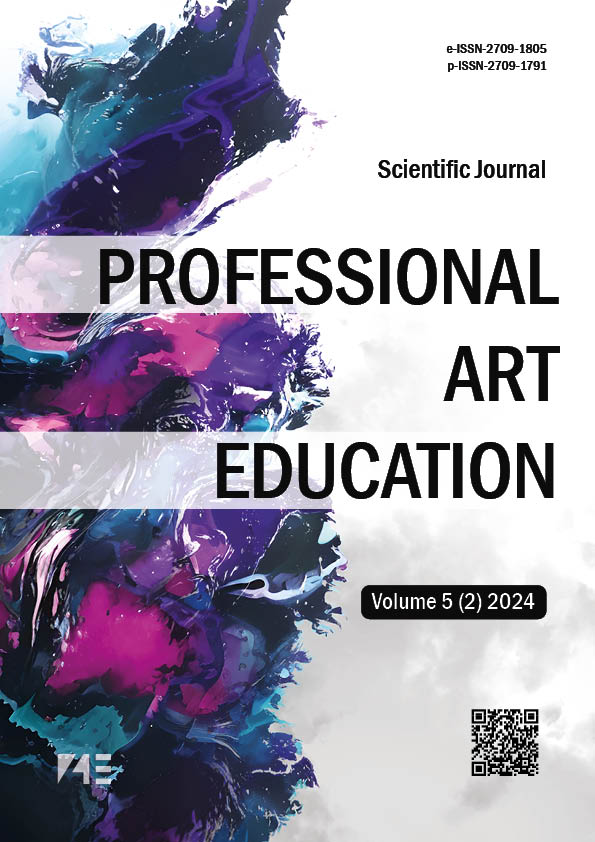Plastic implementation of the melodic and intonation sphere of music in modern dances
DOI:
https://doi.org/10.34142/27091805.2024.5.02.07Keywords:
contemporary dance, plasticity, choreoplasticity, melodic-intonation sphere, melody, texture, harmony, polyphony, linear contour, plastic relief of danceAbstract
The article attempts to reveal the meaning of the phenomenon of plasticity in musical and choreographic art, particular in modern dance.
Methods and methodology. The study used methods of search-analytical, structural-typological, comparative, prognostic and generalizing analysis, which allowed to reveal the meaning of the plastic embodiment of the melodic-intonational sphere of music in modern dances.
The scientific novelty lies in the reflection of the phenomenon of plasticity in musical and choreographic art; the isolation of the principles of the plastic embodiment of the melodic-intonational sphere of music in modern dance.
The results of the study showed that plasticity is a transmission channel through which the integrative interaction of music and dance occurs. It has been established that modern dance, or contemporary dance, the peculiarity of which is the mixing of all dance languages into a single conglomerate, is a historically conditioned manifestation of the 20th century - the era of revolutionary transformations of the ballet theater, the search for a new plastic language, the emergence of unprecedented choreographic concepts and forms, sometimes awakening interest in music and understanding its laws. The principles of plastic reflection of music in dance, in particular its melodic and intonation sphere, are highlighted.
Conclusions. It has been established that the musical poetics of choreography, as a plastic embodiment of the means of musical expressiveness in dance, is based on figurative-plastic and aestheticemotional decoding and choreographic transformation in the process of spatial-temporal deployment of all structural elements of musical language, in particular melody, texture, harmony and polyphony. What is valuable is that the organic fusion of these elements determines the lexical unity and integrity of stage solutions in musical and choreographic form.
Downloads
References
Abramovych, O., & Kudrenko, A. (2020). Теоретико-методологічні аспекти пластичної виразності в майстерності актора. Вісник Київського національного університету культури і мистецтв. 3(2), 165–179. https://doi.org/10.31866/2616-759x.3.2.2020.219280
Hogarth, William. (1753). The Analysis of Beauty. London: Printed by John Reeves for the Author, 1753. Fontes 52. 20 July 2010. https://doi.org/10.11588/artdok.00001217
Бігус, О. (2021). Дефініція поняття «сучасний танець» у науковому дискурсі. Вісник Національної академії керівних кадрів культури і мистецтв, (2), 188-193. https://doi.org/10.32461/2226-3209.2.2021.240061
Білодід, І.К. ред., (1970-1980). Словник української мови : [в 11 т.] Київ : Наук. Думка.
Бурська, О.П. & Кулик, Д.О. (2023) Невербальна експресія: форми вираження художньої думки в хореографії та музичному мистецтві (на прикладі балету Крістал Пайт "Body and Soul", 2019). Науковий часопис НПУ імені М.П. Драгоманова: зб. наук. праць. 29 (14). 23-35 https://doi.org/10.31392/NPU-nc.series14.2023.29.03
Вороновська, O. (2018). Категорії «рух» і «рух у музиці»: етимологія, дефініції та взаємодія. Музичне мистецтво і культура, 2(27), 127-139. https://doi.org/https://doi.org/10.31723/2524–0447–2018–27–2–127–139.
Герц, І.І. (2018). Музично-хореографічний синтез у балеті Уве Шольца «Велика меса». Вісник Національної академії керівних кадрів культури і мистецтв: наук. журнал. К.: Міленіум. (1). 160-164.
Зінич, О. (2015). Пластична взаємодія різних образних систем у мистецтві балету (аспект співвіднесеності музичного та хореографічного руху). Студії мистецтвознавчі. (1). 14-24. http://nbuv.gov.ua/UJRN/StudM_2015_1_4
Зінич, О.В. (2004). Пластичність у балетній музиці М. Равеля (в аспекті взаємодії мистецтв).[Автореф.дис. канд. мистецтвознавства. Національна музична академія України ім. П.І. Чайковського]
Зінич, О.В. (2009). Пластичність у балетній музиці М. Равеля (в аспекті взаємодії мистецтв): монографія. Київ: ІМФЕ.
Кіндер, К.Р. (2007). Семантика пластичних символів народної танцювальної культури українців [Автореф. дис... канд. мистецтвознавства. Київський національний ун-т культури і мистецтв]. КНУКіМ.
Клещуков, В.П. (2018). Музично-пластична природа хореографічного мистецтва. Музичне мистецтво і культура. 27 (1). 300-309. https://doi.org/10.31723/2524–0447–2018–27–1–300–30
Коновалова, І. (2022). Форми репрезентації мелодико-гармонічних взаємозв’язків на рівнях ладу і фактури в музичному мистецтві нового часу. Актуальнi питання гуманiтарних наук. 58 (1), 87-93. https://doi.org/10.24919/2308-4863/58-1-13
Лифар, С. (2007). Спогади Ікара / з фр. пер. Г. Малець. К. : Пульсари.
Степурко, В.І. (2020). Аналіз музичних творів : навчальний посібник. Київ: НАКККіМ.
Чжоу, Сіньюй. (2019). Поліфонічна форма музики ХХ століття як тип письма та спосіб мислення. Науковий часопис НПУ імені М.П.Драгоманова. 27 (14). 136-142. https://doi.org/10.31392/NPU-nc.series14.2019.27.22
Шариков, Д.І. (2010). "Contemporary dance" у балетмейстерському мистецтві: Навчальний посібник. К.: КиМУ.
Шип, С.В. (1998). Музична форма від звуку до стилю: навчальний посібник. К. Заповіт. 368 с.
Downloads
Published
License
Copyright (c) 2024 Наталія Бугаєць, Ольга Пінчук (Автор)

This work is licensed under a Creative Commons Attribution-NonCommercial 4.0 International License.














